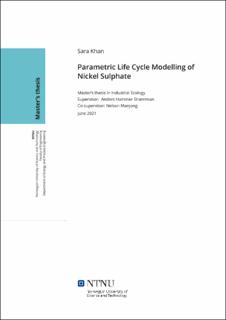| dc.description.abstract | Constant growth of population is raising the energy demand as well as the
environmental impacts and emissions from the use of this energy. To reduce these impacts and
emissions, and to conform to the international agreements on climate change, many countries
are adopting renewable energy sources for the power supply especially for electric cars. The
increasing use of renewable energy and electric cars raises the demand for batteries. The actual
goal of reducing the emissions by using renewable energy can only be met if the emissions
from battery production are also low. Hence, reduction from battery production is a huge
concern to actually lessen the environmental impacts.
One main concern from battery production is the Global Warming Potential (GWP) of
batteries. Reducing the footprint of the inputs that go into the batteries can reduce the overall
battery input. The data on metal supply for battery production is required to have a better
traceability of emissions, so that the sustainable production of the inputs can take place. This
thesis aims to study the environmental impacts of producing nickel sulphate through Lifecycle
Assessment using a Parametric Model.
Some parameters that have an influence on the production of Nickel sulphate such as
Ore grades, Mine-types, Electricity mixes and recovery efficiency from different stages i.e.
beneficiation, primary extraction, refining, are chosen as free variables. In addition, the
influence of allocation type on the results is also studied. 720 scenarios are formed with the
combinations of different values for these six parameters. An inventory for each of the scenario
is built that eventually generate 720 results from LCA. The level of influence of ore grade,
mine-type, and recovery efficiencies on the GWP is studied for different electricity mixes that
correspond to different regions. Ore grade and recovery efficiencies show a negative relation
to the GWP for all the electricity mixes. The GWP for underground mine-type is higher than
the open cast mine. Influence of Mass and economic allocation on the results are studied with
respect to the electricity mixes as well as on different nickel sulphate production stages. | |
